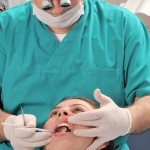
Oral Cancer presents a major global health burden with around 6500 cases of oral cavity squamous cell carcinoma (OSCC) per annum in the UK. Despite improvements in the management of OSCC survival rates have not improved significantly with late presentation being common. Identification at an early stage would improve prognosis and reduce morbidity. Conventional oral examination (COE) is the cornerstone of identification of OSCC and a range of oral conditions (leukoplakia, erythroplakia, proliferative verrucous leukoplakia, oral lichen planus/oral lichenoid lesions, oral submucous fibrosis, and actinic keratosis) collectively referred to as oral potentially malignant disorders (OPMD).
The aim of this review was to evaluate diagnostic accuracy of COE (visual inspection) compared with incisional or excisional biopsy (gold standard) for the diagnosis of OSCC and/or OPMDs in patients with a clinically evident oral lesion.
Methods
Searches were conducted in the Medline, Embase, CINHAL and Cochrane Library with no language or date restrictions. Diagnostic test accuracy studies in patients with oral lesions or OPMDs providing sensitivity and specificity data published after 1990 were considered. Study selection was carried out by a single reviewer with a 10% sample checked by a second reviewer. Data was extracted by a single reviewer and independently checked by a second reviewer. Study quality was assessed using the Quality Assessment of Diagnostic Accuracy Studies-2 (QUADAS-2) tool. A narrative synthesis was undertaken with random effects meta-analyses. Pooled estimates of sensitivity and specificity with 95% confidence intervals (CIs) for COE versus biopsy were presented.
Results
- 18 studies published between 1998 and 2016 were included.
- Study sample sizes ranged from 10 – 3067 patients and 28 to 3067 lesions.
- The index test (COE) was performed by a range of dental or medical professionals, oral surgeons, neck and head surgeons or dental oncologists, oral medicine specialists, otolaryngologists, oral and maxillofacial surgeons, dental oncology specialists, primary care dentists, dental hygienists and dental hygiene therapists.
- In the 18 studies the sensitivity ranged from 25% to 100% and specificity from 24% to 100%.
- 14 studies contributed to the meta-analysis and the summary estimates for COE for dysplastic or malignant lesions are shown in the table below
| Pooled estimate (95%CI) | |
| Sensitivity | 71% (57% to 81%) |
| Specificity | 85% (68% to 94%) |
| False positive rate | 15% (6% to 32%) |
| False negative rate | 29% (19% to 43%) |
- 7 studies reported data on malignant only lesions sensitivity ranged from 67% to 100% and specificity from 26% to 100%. Summary estimates form the meta-analysis are shown below
| Pooled estimate (95%CI) | |
| Sensitivity | 88% (73% to 95%) |
| Specificity | 81% (51% to 95%) |
| False positive rate | 19% (5.5% to 49%) |
| False negative rate | 12% (5% to 27%) |
Conclusions
The authors concluded: –
The pooled diagnostic accuracy of COE versus incisional or excisional biopsy for identifying dysplastic and/or malignant lesions is 71% sensitivity and 85% specificity, with a slightly better sensitivity of 88% and specificity of 81% for identifying malignant lesions only. The evidence on diagnostic accuracy for different types of dental or medical professional in identifying dysplastic or malignant lesions was inconclusive due to the limited number of studies identified. This review highlights the need to improve the diagnostic accuracy of detecting malignant and/or potentially malignant oral lesions at an early stage of the disease in order to improve prognosis and outcomes. In addition, further well-designed studies are needed to compare the accuracy of different members of the dental and medical team in detecting malignant and non-malignant oral lesions.
Comments
Two recent Cochrane reviews have evaluated diagnostic tests for oral cancer in apparently healthy adults (Dental Elf – 12th Jan 2022) and adjunctive diagnostic tests for oral cancer and OPMDs in patients with clinically evident lesions (Dental Elf – 23rd Jun 2021). So, this review fills a gap by evaluating the sensitivity of COE alone in diagnosing oral cancer and OPMDs. In the adjunctive tests review the Cochrane reviewers stated;
At this point in time, none of the adjunctive tests can be recommended as a replacement for the current standard of a surgical or scalpel biopsy and histological assessment.
This review found sensitivities and specificities for COE similar to those of the adjunctive tests which were all conducted in secondary care as we all but one of the studies included in this review. Consequently, biopsy and histology is likely to remain the current standard for oral cancer diagnosis at this time. The primary care practitioner needs to be aware of the clinical appearance of OSCC and OPMDs and remain vigilant for them during routine oral examinations in practice and be active in persuading patients to stop using tobacco and betel quid and to consume alcohol within recommended limits as these are well recognised risk factors.
Links
Primary Paper
Essat M, Cooper K, Bessey A, Clowes M, Chilcott JB, Hunter KD. Diagnostic accuracy of conventional oral examination for detecting oral cavity cancer and potentially malignant disorders in patients with clinically evident oral lesions: Systematic review and meta-analysis. Head Neck. 2022 Jan 29. doi: 10.1002/hed.26992. Epub ahead of print. PMID: 35092324.
Other references
Dental Elf – 12th Jan 2022
Early detection of oral cancer and oral potentially malignant disorders
Dental Elf – 23rd Jun 2021
Dental Elf – 8th Aug 2018
